This Traeger Smoked Brisket is seasoned with a homemade BBQ rub and served tender and juicy with the perfect smoke ring. This recipe works for any smoker or pellet grill.
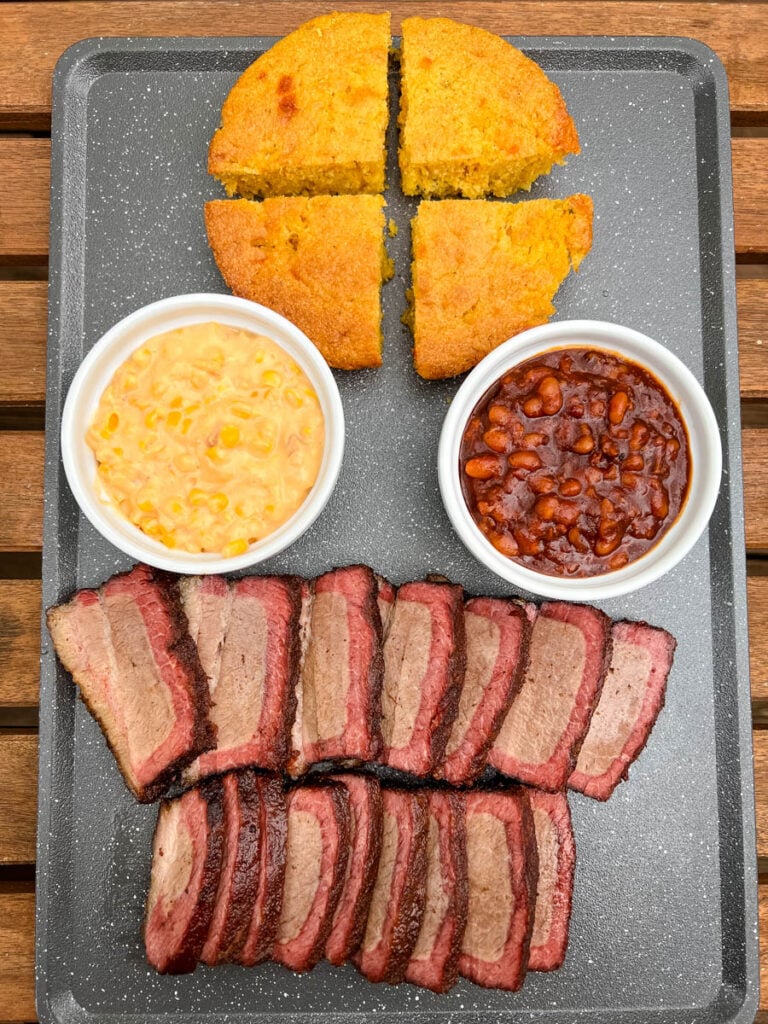
Want to save this recipe for later?
Our family loves to enjoy brisket for cookouts and holidays like Easter and Christmas. A 3 pound cut works great for a small family. This recipe will also work for large brisket up to 18-20 pounds.
Table of Contents
What Cut of Meat is Brisket
Brisket is from the lower chest of the cow and is considered a primal cut of meat. It has a lot of tough connective tissue, so the brisket is usually cooked on a low setting for a long period of time to break down the tissue and get the brisket juicy.
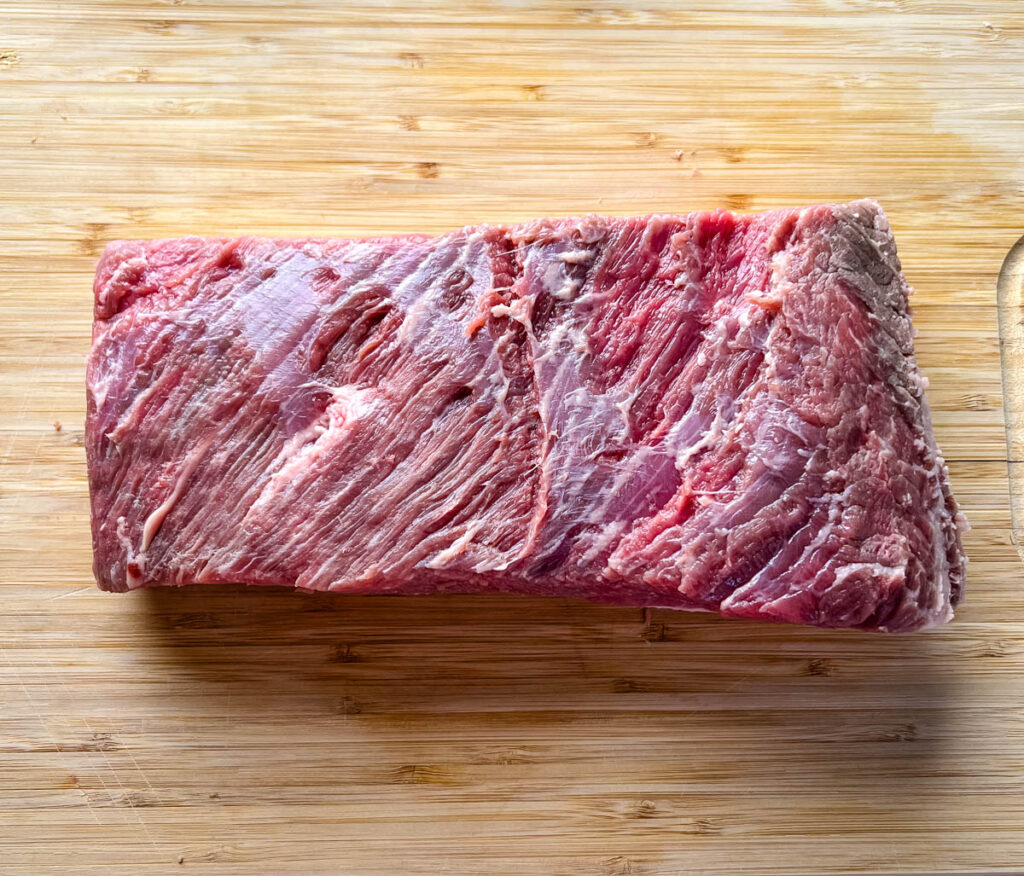
Which Brisket to Buy
Most grocery stores will cut the brisket into 2 categories, the flat and the point. The flat is really easy to slice. I usually purchase only the flat. The one I used for this recipe weighed 3 pounds. Most cuts are much larger. The point has more fat and falls apart easily when cooked. It’s really tender.
You can also purchase a cut of brisket that has both the flat and point.
Purchase the right size that will work for the amount of people you plan to serve. Typically, you should plan for ½ pound of meat per person. Keep in mind brisket is mostly fat. So you may need to buy larger than you think you will need.
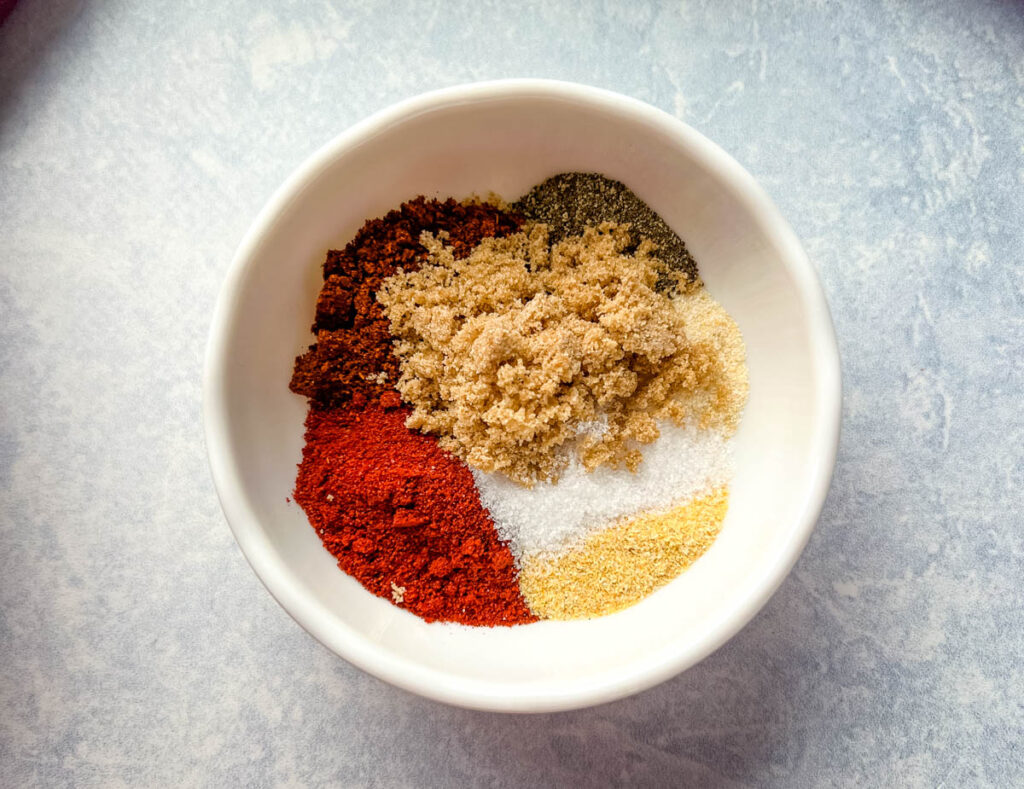
How to Season it
I love to use my Homemade BBQ Seasoning and Rub. You can use any of your favorite rubs. You should be really generous with the amount of rub and spices you use because brisket is a large and thick cut of meat. You want the spices to penetrate the meat and enhance the flavor.
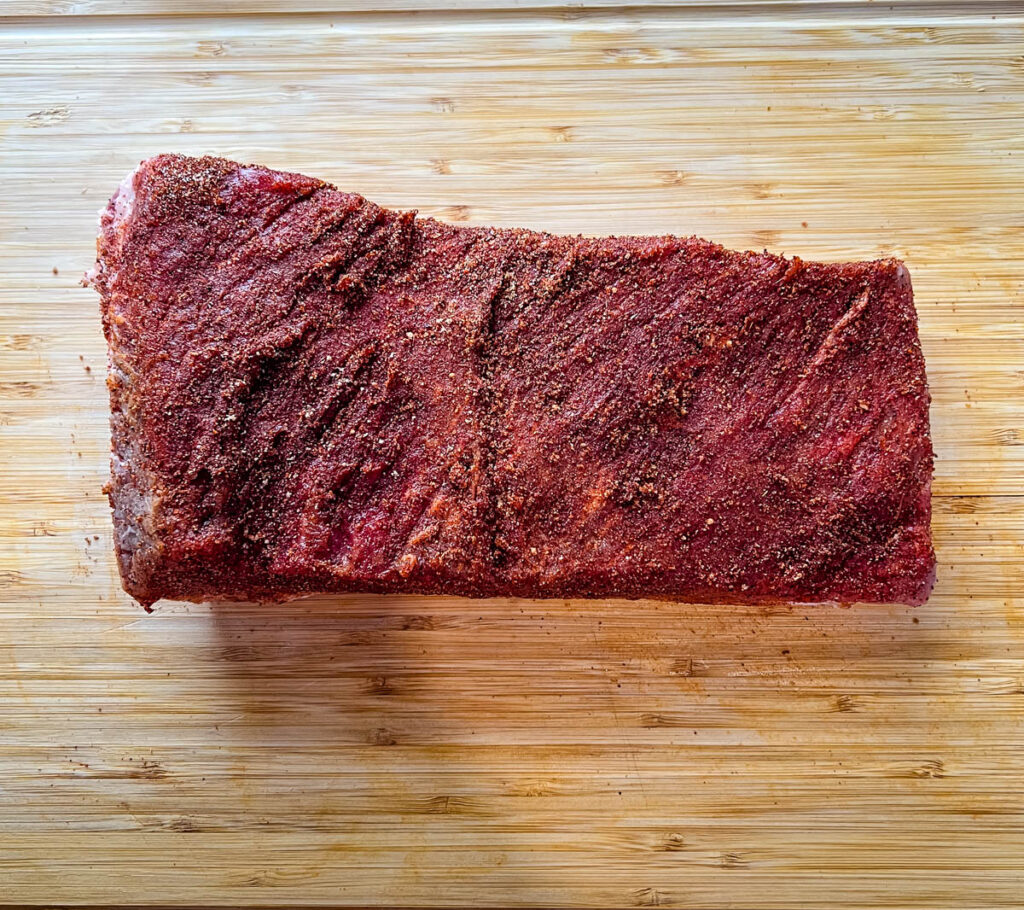
How to Make Traeger Smoked Brisket
Detailed measurements and full instructions can be found in the recipe card at the bottom of this post.
- Trim any excess fat along the top of the meat of the brisket.
- Fully coat the brisket with the rub, salt, and pepper to taste. Place the brisket in the fridge to absorb the flavor of the spices.
- Smoke until it reaches an internal temperature of 175 degrees.
- Remove the brisket from the smoker and drizzle it in butter and apple cider vinegar. Wrap it tightly in butcher paper or foil.
- Add the wrapped brisket to the smoker and cook until it reaches an internal temperature of 203-205 degrees.
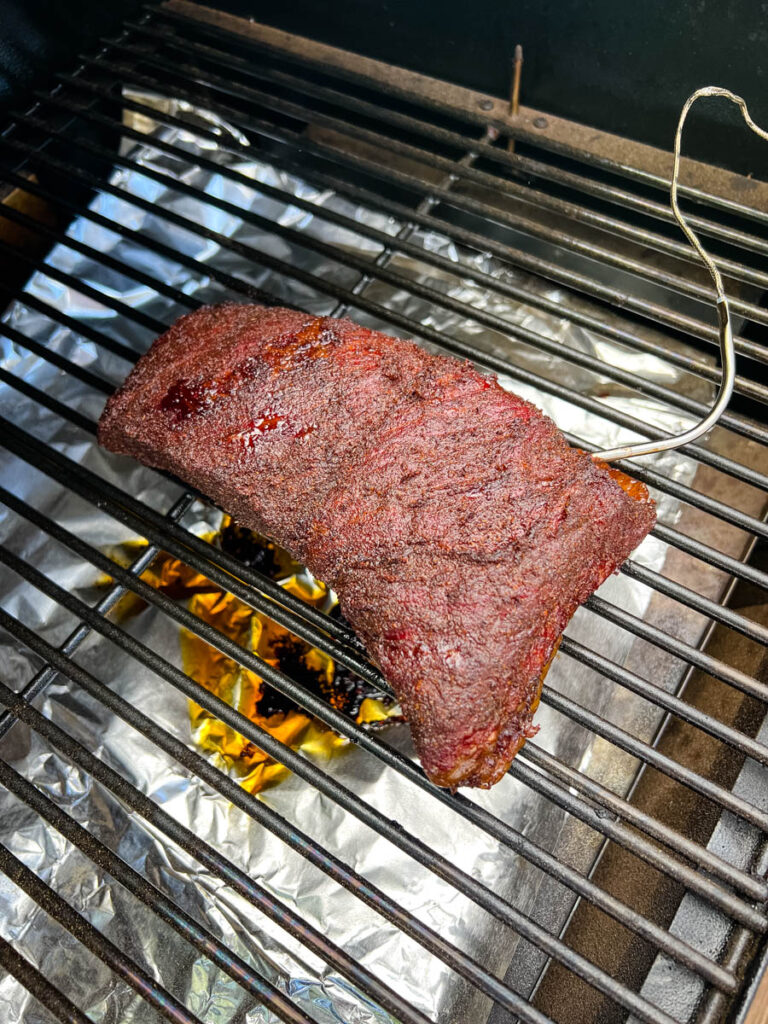
Foil or Butcher Paper (Peach Paper)?
Not everyone wraps their meat during the final stages of a cook. I like to because brisket is something that is cooked long and slow. The longer it cooks the more likely it is to dry out if you don't wrap it.
I used butcher paper, but either butcher paper or foil will work well. I like to use butcher paper because I feel like the smoke flavor continues to penetrate into the flavor of the meat, more so than foil will. Butcher paper is more breathable and traps less steam. This will help keep the brisket moist without making the bark (top coating) soggy.
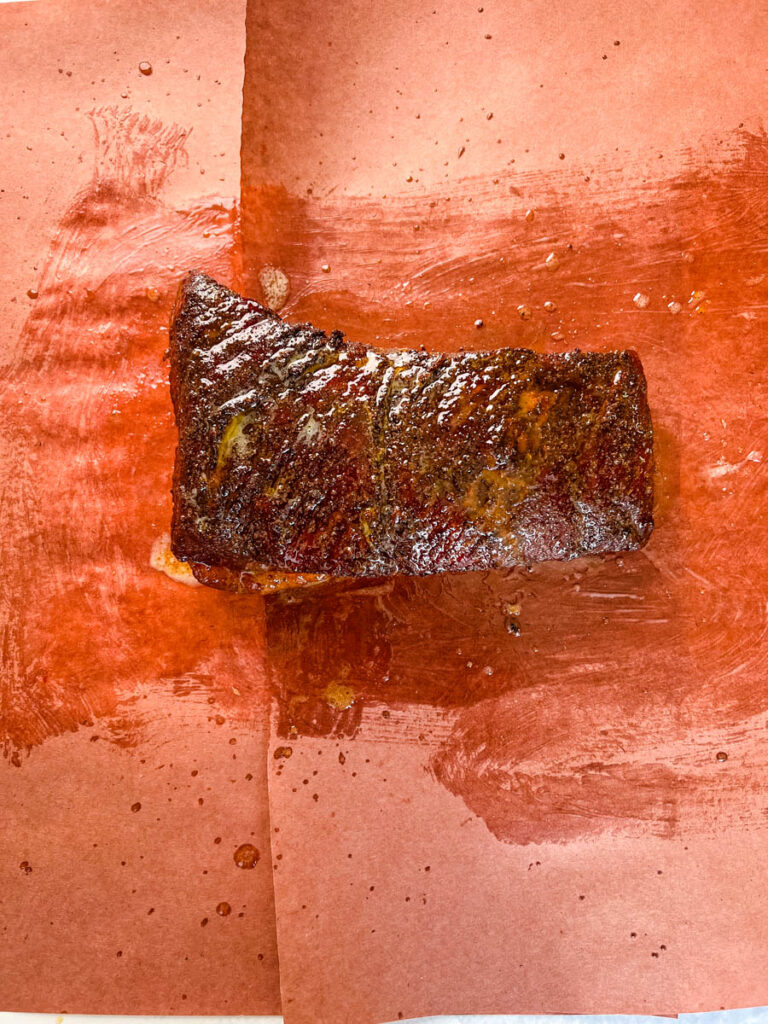
Foil-wrapped brisket will cook faster than butcher paper-wrapped. Wrapping in foil will capture the fat from the juices of the meat which is reabsorbed and creates juicy brisket. Because it creates an overly moist environment, this typically results in soggy bark (the coating at the top).
Smoke Ring
Smoked brisket is widely praised when it has a visible smoke ring. The smoke ring is the outer edge of a sliced piece of meat and is typically a bright pink color compared to the dark interior color of the remaining meat on the slice.
The smoke ring is just under the surface crust that's commonly refered to as the bark. It can be just a thin line of pink or a rather thick layer. A good smoke ring is usually around a ¼ inch in thickness.
The ring is produced by a chemical reaction between the pigment in the meat and the gases produced from wood or charcoal. When burned, these organic fuels produce nitrogen dioxide gas. You can read more about the scientific creation of the smoke ring here.
The ring is an indication that the meat was smoked low and slow. Some argue that it's hard to achieve on a Traeger or any pellet grill, but here are a few tips that helped me achieve it:
- Apply the rub and spices to the brisket while cold and then refrigerate it until you are ready to smoke it. Don't allow the meat to come to room temperaure before placing it on the grill.
- Start by smoking the brisket at a low temperature. I use 175 degrees and smoke it overnight since the process is so lengthy.
- Some people also use pans of water to help, but I don't find it necessary.
I've also had plenty of delicious brisket without a smoke ring.
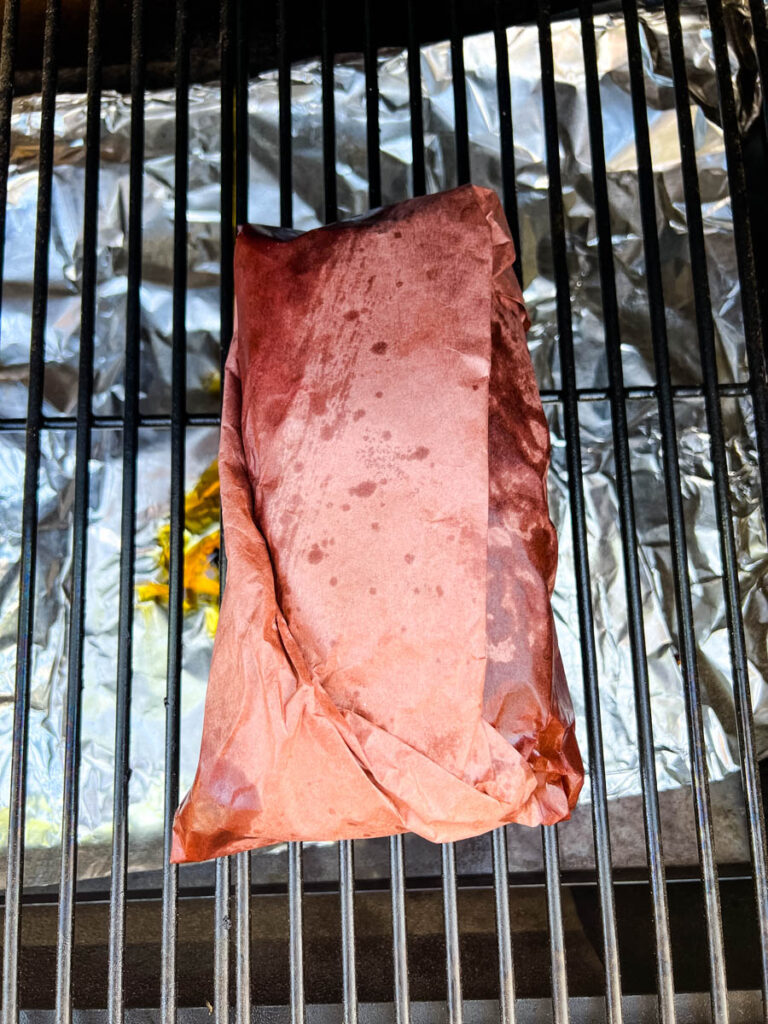
Cook Time/How Long to Cook
Brisket takes a long time to cook. I like to start it overnight before bed, that way I can wake up, wrap it and let it cook for an additional few hours. For the first step, you smoke the brisket until it reaches an internal temperature of around 170 degrees. Because I smoke it overnight, I keep the temperature around 175 degrees to ensure it doesn't overcook overnight.
Once it reaches an internal temperature of around 170 degrees, wrap the brisket to ensure it's juicy and moist. From here, you smoke it until it reaches an internatl temperature of 203-205 degrees. This entire process can take up to 12 hours or more depending on the size of your meat.
You can also smoke the brisket at 225 degrees for the entire cook, if that's what you prefer. The standard rule of thumb is about an hour and a half to two hours per pound of meat.
Electric and gas smokers cook at consistent temperatures which makes it easier to predict cooking time per pound than for pit or barrel smokers. Keeping the lid closed contains heat and shortens the cooking time. If you're consistently checking in this will increase the cook time.
Other relevant factors include the thickness and grade of the meat, the amount of fat, and the weather conditions. On a cold, windy evening, a brisket can take more than two hours per pound to cook. A higher grade of brisket that has more marbling and fat usually will cook more quickly than a lower grade.
Tough Brisket
Tough brisket is usually the result of undercooking, cooking it at too high of a temperature, or not wrapping it so it dried out.
What Type of Wood/Pellets to Use
My favorites are hickory and mesquite. Those will produce a nice amount of smoky flavor. Oak, cherry, maple, and apple will also work well along with the Traeger Signature blend.
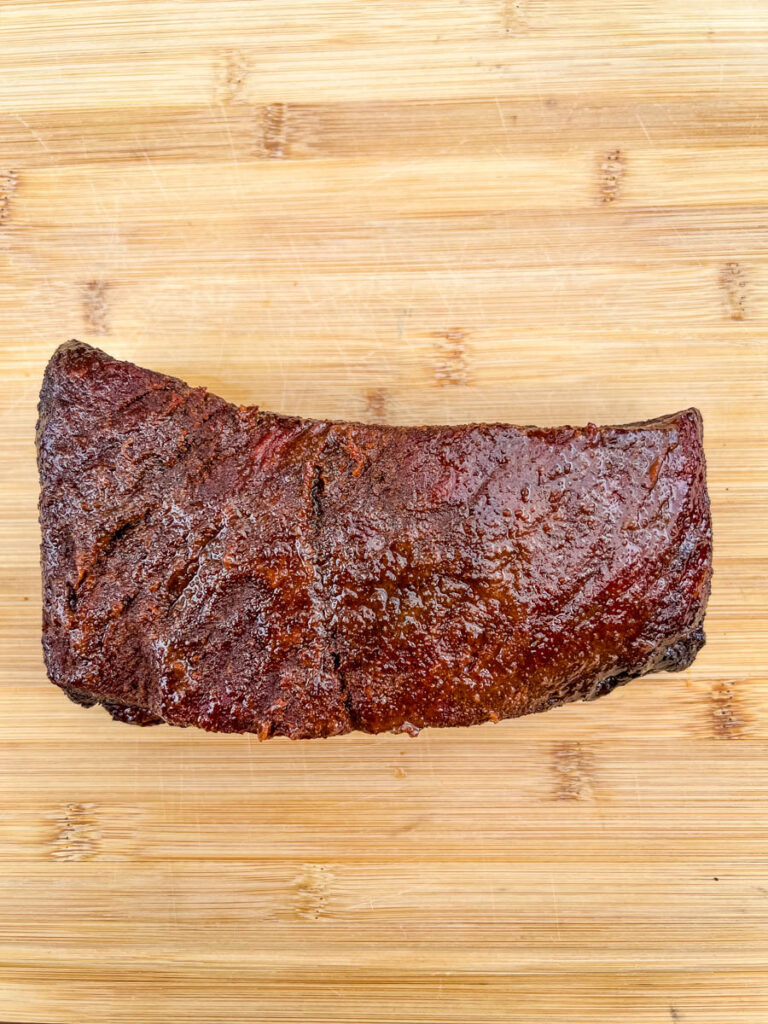
Allow the Brisket to Rest
The longer the brisket rests the better. The typical rule of thumb is 30 minutes. I recommend at least an hour to 2 hours. Allowing the meat to rest will allow all of the juices to redistribute into the meat and result in juicy brisket. If you slice into it too soon you will lose most of the juices which results in dry brisket.
How to Separate the Point From the Flat on a Cooked Brisket
The brisket flat is usually slightly larger than the point and is rectangular and easy to find on most grocery store shelves. (I usually don't have to do this step because only the flat was purchased). The flat is leaner but typically has a fat cap attached.
The point is shaped like a triangle with more fat content.
Identify where the point meets the flat on the brisket. There’s usually a line of fat that separates the two. Start by cutting down on the fat. Keep lifting the flat as you cut to separate the two. You can check out more tips on How to Slice Brisket here.
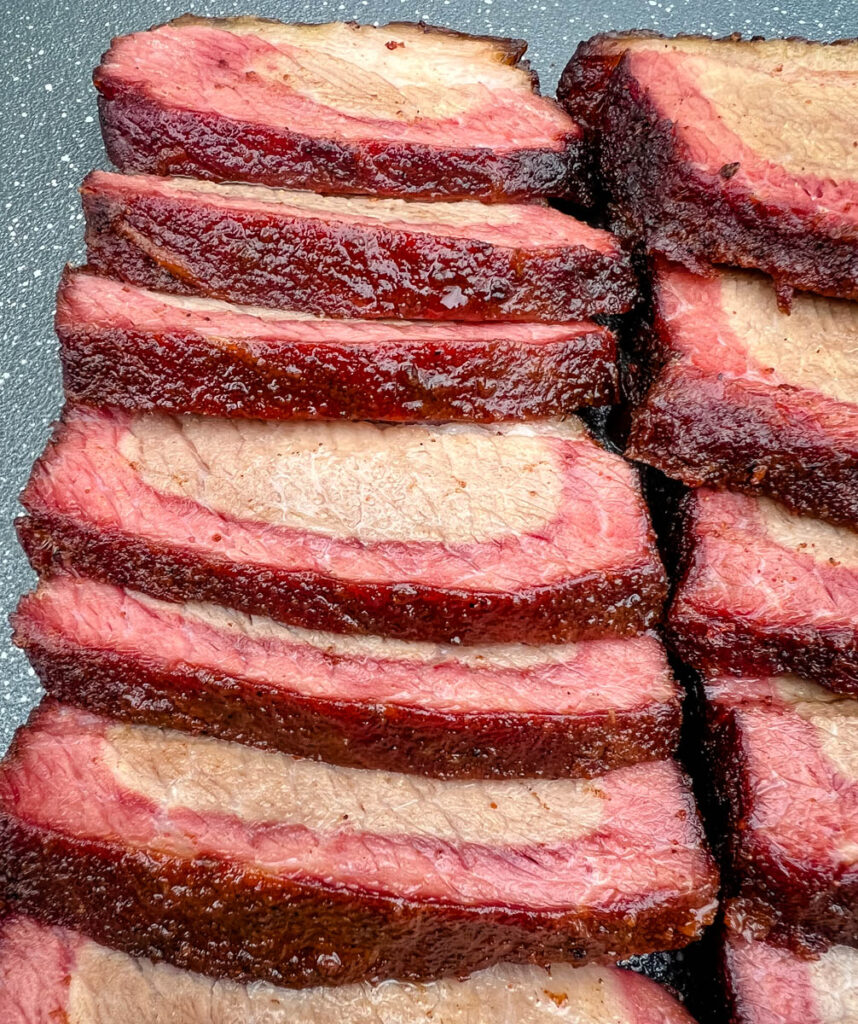
How to Slice
Typically, brisket is sliced into slices about ¼ of an inch thick. Slice against the grain the meat. The grain is the direction the meat fibers go in. Slice against it, to avoid drying out the meat.
How to Store Leftovers
You can store the brisket, covered, in the refrigerator for 2-3 days.
How to Reheat
Reheat sliced brisket in the oven or air fryer on 325 degrees. Drizzle the brisket with a little broth and/or BBQ sauce first. Reheat it until it reaches an internal temp of 145-160 degrees. Reheating brisket in the microwave usually results in dry brisket
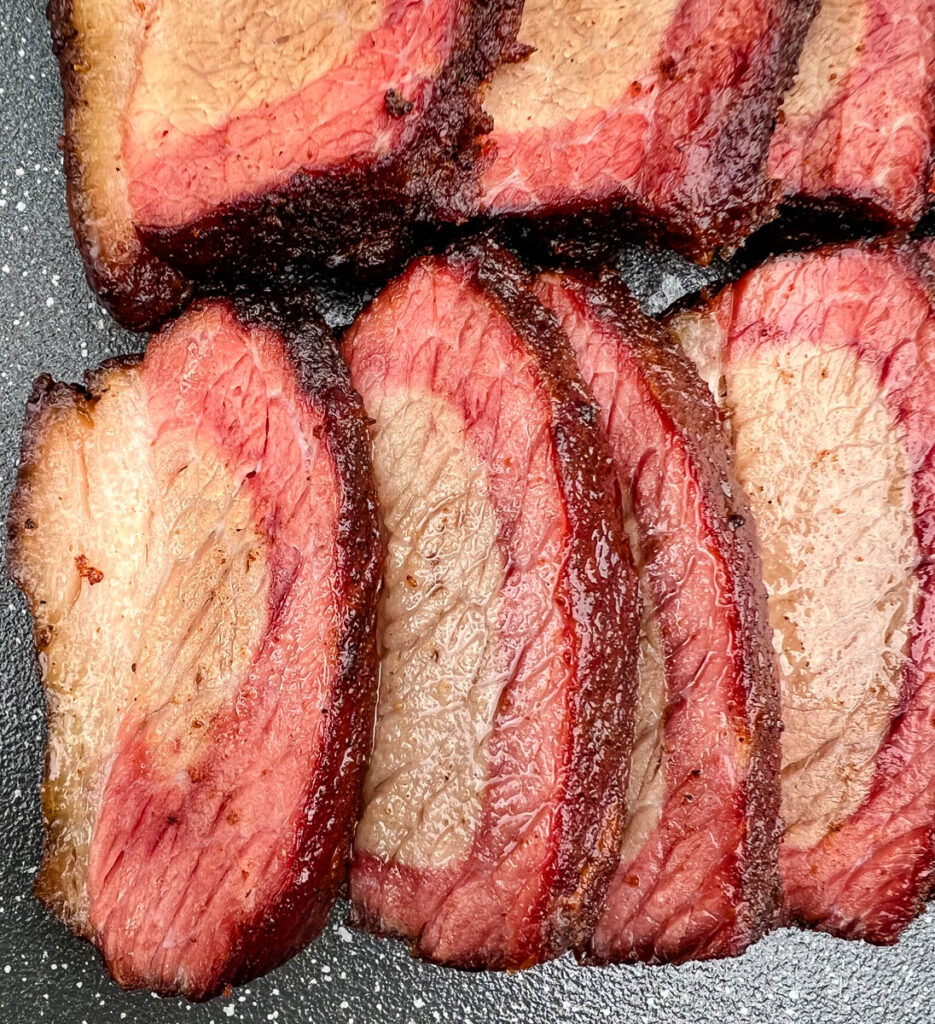
Freezer Tips
If you freeze the brisket whole, thaw it out, and then reheat it in the oven at 325 degrees. Cover with foil and reheat for about an hour. If you freeze the brisket in slices, thaw it out, and then reheat it in the oven at 325 degrees. Drizzle the brisket with a little broth and/or BBQ sauce first.
Pair With these Recipes
Smoked Mac and Cheese
Southern Baked Beans
Bow Tie Pasta Salad
Bacon Ranch Pasta Salad
Broccoli Salad with Cheese and Bacon
Southern Potato Salad
Southern Coleslaw
More Traeger and Smoker Recipes
Traeger Smoked Whole Chicken
Traeger Smoked Salmon
Traeger Smoked Bacon
Smoked Salsa
Smoked Lobster Tail
Traeger Smoked Chicken Wings
Traeger Smoked Chicken Breast
Traeger Smoked Turkey
Traeger Smoked Turkey Breast
Smoked Turkey Wings
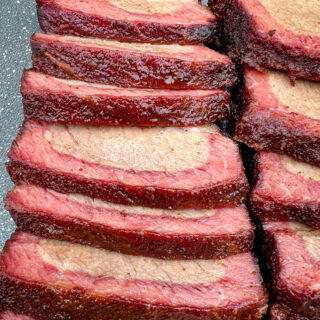
Traeger Smoked Brisket
Want to save this recipe for later?
Ingredients
- beef brisket Any sized brisket will work for this recipe.
- ½-1 cup BBQ or pork rub Use enough spices to fully coat the meat.
- salt and pepper to taste
- 2 tablespoons melted butter Measured solid.
- 1-2 tablespoons apple cider vinegar.
- butcher paper or foil
Instructions
- Trim any excess fat along the top of the meat of the brisket. I like to keep the cap of fat on the brisket. I do not trim it because it helps add flavor to the beef.
- If necessary, separate the point from the flat. Illustrative details can be found here.
- Fully coat the brisket with the rub, salt, and pepper to taste. Place the brisket in the fridge to absorb the flavor of the spices. Minimum 30 minutes, but a few hours to overnight is best.
- Preheat smoker to 175 degrees. I typically cook it overnight and start at 175 degrees to avoid overcooking it. You can also smoke it at 225 degrees.
- Add the brisket to the smoker, fat side down. Smoke until it reaches an internal temperature of 175 degrees.
- Remove the brisket from the smoker and drizzle it in the butter and apple cider vinegar. Wrap it tightly in butcher paper or foil. Be sure it's tight so that the moisture is locked in.
- Add the wrapped brisket to the smoker at 250 degrees fat side up. This will allow the fat from the brisket to seep into the beef as it smokes. Cook until it reaches an internal temperature of 203-205 degrees.
- Remove the brisket and allow the brisket to rest inside the wrap for at least 30 minutes. I allowed it to rest for over an hour before unwrapping and slicing.
Notes
-
My favorite pellets for brisket are hickory and mesquite. Oak, cherry, maple, and apple will also work well along with the Traeger Signature blend.
- Electric and gas smokers cook at consistent temperatures which makes it easier to predict cooking time per pound than for pit or barrel smokers. Keeping the lid closed contains heat and shortens the cooking time. If you’re consistently checking in this will increase the cook time.
- Other cook time factors include the thickness and grade of the meat, the amount of fat, and the weather conditions. On a cold, windy evening, a brisket can take more than two hours per pound to cook. A higher grade of brisket that has more marbling and fat usually will cook more quickly than a lower grade.
- Butcher paper is more breathable and traps less steam. This will help keep the brisket moist without making the bark (top coating) soggy.
- Foil-wrapped brisket will cook faster than butcher paper-wrapped. Wrapping in foil will capture the fat from the juices of the meat which is reabsorbed and creates juicy brisket. Because it creates an overly moist environment, this typically results in soggy bark (the coating at the top).
- Tough brisket is usually the result of undercooking, cooking it at too high of a temperature, or not wrapping it so it dried out.
Nutrition
Nutrition Data
Macros are provided as a courtesy and should not be construed as a guarantee. This information is calculated using MyFitnessPal.com. To obtain the most accurate nutritional information in a given recipe, you should calculate the nutritional information with the actual ingredients used in your recipe, using your preferred nutrition calculator. You are solely responsible for ensuring that any nutritional information provided is accurate, complete, and useful.

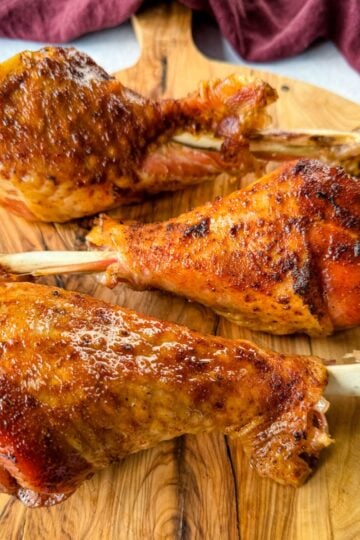
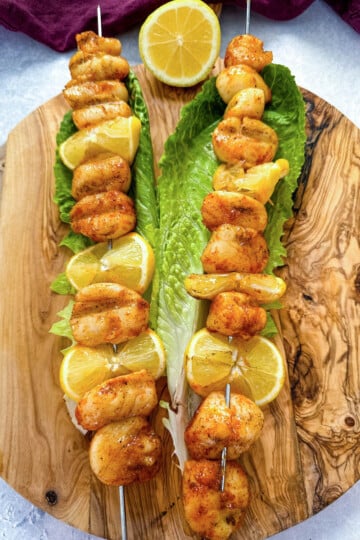
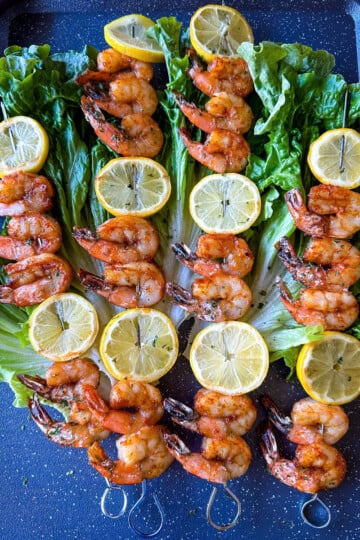
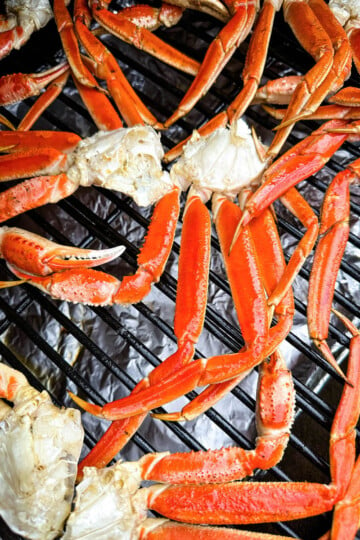
Leave a Reply